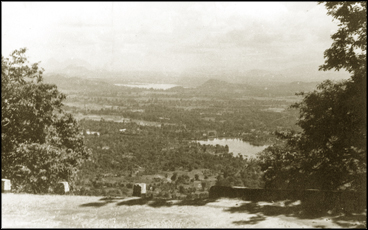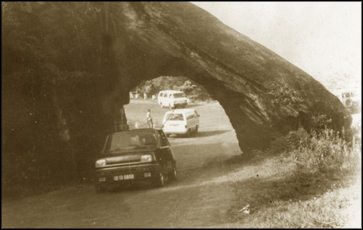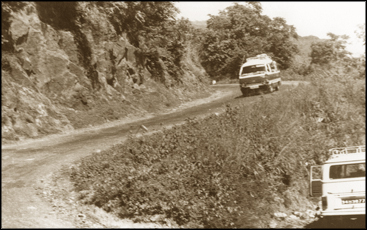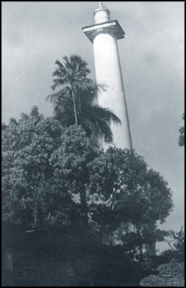The grand old Colombo-Kandy Road down the ages
Text and pix by Gamini G. Punchihewa
In the recent news features that appeared in the Sunday Observer,
mention has been made that this picturesque mountain road encountering
18 elbow bends is to be reduced and rehabilitated by the Ministry of
Road Development Authority. Action has already been taken by the
Ministry concerned in regard to this monumental Road Development
project.
As this subject has turned topical I wish to brief a short account in
this article, Illustrated with photos of its past antecedents.
 |
|
A birdís eye view from
the top of a mountain road. |
|
 |
|
The Kadugannawa road
arch. |
 |
|
Negotiating the 22 elbow bends on the
Kandy-Hasalaka-Mahiyangana mountain road. |
The present Colombo-Kandy finely metalled and carpeted highway is
reminiscent of three modes of transport that existed from ancient
periods and finally culminating in three foreign dominations that held
sway. Those past foreign rulers were first the Portuguese, then the
Dutch and finally the British.
Jungle-paths-cart tracks
 |
|
The Dawson Memorial. |
In those good old days when our ancient kings and queens ruled over
their realms, there existed foot-paths, narrow jungle trails, along
those wisps of cart tracks where bullock carts or the palanquins
carrying the king, and his royal entourage, which were just enough to
penetrate through them. The humble villager had to trek on foot and rest
the overnight at an Ambalama - a way side rest.
Dawson Memorial
The very earliest description about the existence of these paths,
roads and tracks is given in Robert Knox's 'An historical Relation of
Ceylon' (1681 A.D.) as told.
"When they travel together a great many of them, the roads are so
narrow that one can go abreast, and there be twenty of them, there is
but one argument or matter discoursed of among them all from the first
to the last. And so they go talking along all together, and everyone
carrieth his provisions on his back for his whole journey. Among the
well-known ancient pathways that took the Dutch on ambassadorial errands
to the king of Kandy from Batticaloa was the one that ran from
Batticaloa, Kalmunai, Akkaraipattu, Kossapola Hida, Bibula Medagama,
Makara, Nilgala Bibile-Kandy. A part of this old track from
Bibula-Makara had been submerged with the waters of the Senanayaka
Samudraya after the daming of the Gal Oya river in 1950.
With the arrival of the Portuguese and Dutch in the 16th and 17th
centuries, the mode of travel was either the palanquin or two chairs
lashed together with poles (carried by 2-4 men), horse back and the
bullock cart, but it was mostly done by foot. The grand old days of the
horse - carriage (actually it started with the Royal Mail coach) that
ushered in during the "Britannia rules the waves" that was in the early
19th century.
The Dutch on the other hand were masters of building forts and
creating a network of canals in evolving a water transport system. Dr.
John Davy was a British surgeon and physician in attendance to Governor
Sir Robert Brownrigg and Lady Brownrigg (1812-22). In their company,
Davy had to make palanquin tours into the interior of Ceylon.
In his voluminous book titled "An Account of the Interior of Ceylon
and its Inhabitants with Travels in the Island". (1821) says of the
Palanquin travels he had made from Colombo to Kandy in 1817:
"My next visit to the interior was in attendance in a medical
capacity on His Excellency the Governor, who left in company of Lady
Brownrigg, for Kandy on August 5, 1817. The distance of Kandy from
Colombo, by the common road which we went, through the Three and Four
Korales, is eighty five miles. The first stage is to Hanwella, a little
fort on the Kelani ganga, eighteen miles off. The country, thus far, is
either flat or gently undulating well inhabited. The greater part of the
way, the road is most agreeably shaded by the fine foliage of fruit
trees, and especially of coconut trees, which with the exception of
being here and there interrupted by paddyfields, from a continuous line
of groves for many miles along the river....."
"The first obstacle that any traveller using foot, a palanquin or on
horseback was the ferry over the Kelani river which comprised a number
of boats tied together over which men or goods were ferried across. The
British foremost began to construct roads for the use of the military in
marching their company of troops either on foot or by carts drawn by
oxen." The present Colombo-Kandy road was constructed in 1825 under the
able guidance of Major Skinner assisted by General Frazer and Captain
Dawson, during the distinguished governorship of Sir Edward Barnes
(1824-31). Most of the tracings of the road was executed by Major
Skinner. Major Skinner came to Ceylon at the puerile age of 15 years
when he was commissioned as second Lieutenant in the Rifles Regiment, in
1819. In later years he held the posts of Commissioner of Roads in 1841,
Auditor General and also as the Surveyor General.
Besides the Colombo-Kandy road, the other roadways constructed by
Major Skinner were the Kandy-Kurunegala, Arippa-Anuradhapura, Northern
Province, Kandy-Dambulla road and that of the Eastern Province. Major
Skinner's one greatest contribution in the field of map surveying was
the making of the sketch of the Kandyan kingdom which paved the way for
the making of the map of Ceylon. Major Skinner retired in 1861 and he
died in England in 1877.
In those good old days there was a ferry over the Kelani ganga at
Hanwalla built by the British who later built a bridge.
The present Peradeniya Bridge over the Mahaweli ganga was built
originally of solid satin timber - burutha wood in 1833. Major Skinner
was the ingenious builder of it. 'In Major Skinner's 50 years in Ceylon'
he has said:
"In 1833 while I was in charge of the works, the Peradeniya bridge
was completed. This is a very graceful bridge over the Mahaweli ganga
made entirely of satinwood, without a nail or bolt in it. During the
construction, we had a force of twelve hundred men employed in laying
and filling up the approaches".
The other milestone that was laid on the Kandy-Colombo road
constructed during the British regime was the opening of the Royal Mail
Coach in 1831 along this newly constructed road. Fredrick Lewis says
thus in his "sixty four years in Ceylon".
"The Royal Mail Coach used to take its departure on Tuesdays,
Thursdays and Saturdays at 6.00 a.m. and arrive in Colombo between 4 and
5.00 p.m. in those days (1860) we paid Sterling Pounds 2.10.0 for the
journey."
As to the hazards and other discomforts that were encountered, Major
Skinner's comments in his '50 years in Ceylon':
'.....Where fifty years ago a man from Colombo had to trudge six
weeks before he could reach Kandy, and that too with great personal
inconvenience, over scraggy rocks, precipices, and ravines, he is now
able to make the same distance in less than ten hours'.
Opening of the railway Colombo-Kandy
The Railway from Colombo to Kandy was opened for passenger traffic on
the historic day of 30-04-1867, while that of Colombo-Ambepussa was
opened in 1865. Caravans of bullock carts laden with bags of coffee
rumbled down this roadway.
Kadugannawa Pass and Dawson's Memorial
One of the greatest feats of road engineering prowess was the
stupendous construction of the Kadugannawa pass. Sir Emerson Tennent, in
his "Ceylon Vol. II, says:
"The last thirty miles of this wonderful road passes through scenery
which combines the grandeur of Alps with the splendour of tropical
vegetation. It is an Oriental Simplon, climbing hills, crossing
torrents: and following the windings of ravines, till it reaches its
extreme altitude at the pass of Kadugannawa. One of those romantic glens
which the former Kings of Kandy jealously guarded from the low country".
Standing like a lone but tall sentinel, Dawson's Memorial looms into
view up the rocky inclines and precipitous of the Kadugannawa Mountain
pass roadway nestling in the lap of the enthralling mountainscape of the
Kandy frontier. This white monument is a striking one rising about 100
feet....
At the foot of this monument lies a large tablet bearing testimony to
the gallant British engineer who built this awe - inspiring mountain
pass roadway. Etched on this memorial plaque are the following immortal
words.
"Captain Dawson during the government of Sir Edward Barnes K.C.B. and
C. Commanding Royal Engineers, Ceylon, whose science and skill planned
and executed this road, and other works of public utility, died at
Colombo, 28th March, 1829. By subscription this Monument erected to
memory, by his friends and admirers'.
Of Captain Dawson's tragic death, Major Skinner his colleague and
friend, has bemoaned in this way.
"On the 28th March, 1829, I lost a very dear friend and the service
of a most invaluable officer, in Captain W. Dawson, Commanding Royal
Engineers. The poor fellow died in my arms.
The whole island moaned him. Where he was known he was dearly loved.
Sir Edward Barnes had not - withstanding Dawson's junior rank, selected
him for the position of C.R.E. which was a Colonel's command, for Sir
Edward Barnes knew from his peninsular experience of him the great
merit, Dawson possessed as an officer. A singular coincidence occurred
in reference to the monument erected to his memory on the rock of the
Kadugannawa pass which was one of the triumphs of his skill.
The foundation of this column was laid at the same time as that to
the memory of His Royal Highness the Duke of York, late Commanding - in
Chief at the entrance to the Park at the end of Waterloo Place (London).
The dimensions of these two monuments are identical the only
difference in them being that Dawson's monument is built of brick,
whereas that erected to the Commanding - in Chief is of granite,
Dawson's remains were interred in a vault in Saint Peter's Church,
Colombo' ("50 years in Ceylon") - Major Skinner.
Picturesque Mountain Passes
The beautiful and scenic hill country of Kandy is pregnant with
panoramic kaleidoscope views of stupendous mountain passes and lofty
mountains rising and falling in all facets.
Perched among these enthralling but magnificent tops clothed in rock
and woods stands in all its serenity, the fortress like tower called the
Bible Rock or Battalagala. The British rulers had named this rock
romantically - as the 'Bible Rock'.
Legend says that King Valagambahu to escape the wrath of the
invaders, took shelter in one of these caves.
Climbing up the delightful mountain highway of the aweinspiring
Kadugannawa and the Balana pass, the motorist or pedestrian would be
thrilled with fascination to pass through the narrow tunnel of this
well-known Kadugannawa pass.
Still motorists prefer to go through this unique mountain pass
sheltered by the wonderful arch of a rock boulder at times for security
purposes, this road tunnel happens to be closed, by placing a barrier of
wood or some stone on the entrance and exit of this road tunnel across
its approaches.
But in recent - times those obstructions have been removed where
desirous motorists could pass through safely enjoying its thrill with
amusement. |

